This post may contain affiliate links. Where I make a small commission on purchased items, at no extra cost to you. See my disclosure for details.
(This post has been updated from the original May 2014 version to provide a better experience for you)
Flaky shortcrust pastry filled with a smooth and creamy butterscotch filling – butterscotch tart is the stuff of childhood dreams! Adapted from an original dinner lady recipe, this classic school dessert will take you straight back to your childhood (just like cornflake tart and treacle tart do!). Learn how to make your very own with my nostalgic recipe, helpful tips and much more…

I’ve always been a huge fan of desserts. From apple crumble to sticky toffee pudding, it’s a world of sweet, all encompassing comfort!
And I loved butterscotch tart so much in school that I used to skip dinner and have two puddings whenever it was on the menu! So on my very last day in secondary school, I actually asked a dinner lady for their butterscotch tart recipe.
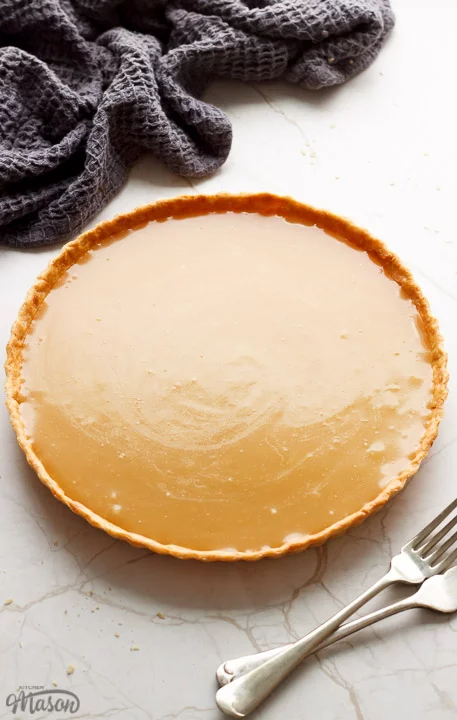
She wrote it down on a scrappy little piece of paper for me. Sadly, after leaving home, the recipe got mislaid and I thought it was lost forever. Until one day, to my surprise and delight, I found it in a little box at my parent’s house!

I was so so happy! It was a little on the vague side but I was determined to fill in the gaps and share the recipe with the world. After all, I knew you’d love it as much as I did. (Being in Kitchen Mason’s top 5 recipes every day since I originally published it in 2014 proves as much!)

Alternative names
This old school dessert goes by many names across the United Kingdom. Butterscotch tart, caramel tart and even gypsy tart. But they were all slight variations of the very same thing and all tasted amazing! If you know of any more names for this dessert, let me know in the comments below or email me at emma@kitchenmason.com.

What you need to know
In this section I’m going to help you understand everything you need to know in order to make butterscotch tart perfectly first time! From notes on the ingredients you need, right down to making perfect shortcrust pastry and helpful tips. Trust me, this is a worthwhile read!
But if you’re still unsure, read through baking for beginners first, to boost your confidence and baking knowledge.

Butterscotch tart ingredients
While mostly very basic, there are a few key things you need to know about some ingredients when making butterscotch tart.
For the pastry
- Flour – Always use plain (all purpose in the US) flour for shortcrust pastry.
- Salt – Table salt is fine. You’re going for flavour here not texture.
- Butter – I always use unsalted as it puts me in full control of the salt content/flavour.
- Water – No need to get fancy, tap water is fine!
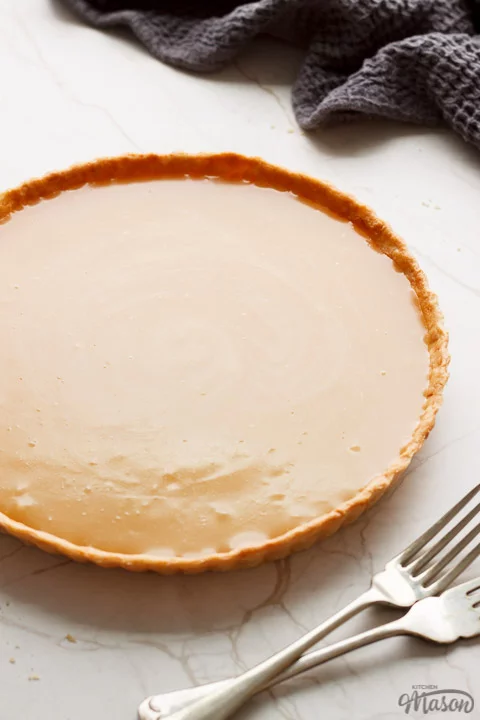
For the butterscotch filling
- Milk – Whole/full fat milk gives the best flavour but most milks (including dairy free) will work.
- Flour – Again, plain (all purpose in the US) flour works best in this recipe.
- Butter – Use unsalted to give you control of the salt content and overall flavour.
- Sugar – Golden caster sugar is my favourite but light brown soft sugar would work well too.
- Salt – As you’re looking for flavour not texture, table salt is perfect.
- Vanilla Extract – A very good quality vanilla (like Nielsen Massey) is key in this recipe!
- Butterscotch Essence – The single most important ingredient for authentic flavour. Whatever you do, don’t leave this out!
Here is where I get my butterscotch essence. (Affiliate link.)

Making shortcrust pastry
Worried about making the shortcrust pastry case? There’s no need! Check out my easy shortcrust pastry recipe. It’s packed full of super helpful tips to help you nail it first time!
Still not sure or short on time? You can always buy a 20 cm / 8″ ready made pastry case from your local supermarket instead.

How to make butterscotch tart: recipe summary
It’s much easier than you think! You can even cheat and buy a ready made pastry case if you like. I always believe homemade is better though.
- Mix flour, cold butter and salt to fine crumbs then add water. Mix to form a dough and rest in the fridge.
- Roll out and line a fluted tart tin. Blind bake then cool completely.
- Mix the milk and flour together.
- Melt together butter and sugar in a large saucepan.
- Gradually add the milk/flour mixture and stir until thickened.
- Remove from the heat and stir in salt, vanilla and butterscotch essence.
- Pour into the case and allow to set completely.
- Slice and serve.

Butterscotch tart tips and troubleshooting
Now we’re into the good stuff!! Here’s some super helpful tips (born from me making the mistakes so you don’t have to!) that I think will really help you out.
Helpful tips
- Use a pastry blender to make your pastry. They’re cheap and make pastry quicker, easier and better!
- Don’t have a pastry blender? Make sure you have cold hands, cold butter and cold water instead.
- Try not to overwork your pastry. It will become chewy and not very nice. A light touch is key!
- Add the water gradually to your pastry. Remember, you can always add more but you can’t take it out!
- Flattening your pastry into a disc before refrigerating will chill it faster. (Due to the larger surface area.)
- Don’t have time to make your own shortcrust pastry case? Buy a ready made one and fill as per the recipe.
- Do not leave out the butterscotch essence! It’s the key ingredient to making it taste exactly as it did in school.
- Be patient with the butterscotch filling. It needs to be the consistency of wallpaper paste to set properly.
Can’t find butterscotch essence? I’ve used this one and this one. Both worked great. (Affiliate links.)
This is the pastry blender I use. (Affiliate link.)

Troubleshooting
- My pastry was chewy – You overworked it. Try using a pastry blender and a lighter touch next time.
- The pastry was soft – you didn’t bake it for long enough. Cook until it’s golden brown and crispy to the touch.
- My filling didn’t set – You didn’t stir it over the heat for long enough. It needs to get to the same consistency as wallpaper paste.
- The filling set too firm – You stirred it over the heat for too long and it became too thick. Think wallpaper paste for the perfect consistency.
- My tart doesn’t taste like it did in school – You didn’t add the vanilla extract/butterscotch essence. Add them both for an authentic old school flavour.

Butterscotch Tart – Step by Step Picture Recipe
(For a printer friendly version, see the recipe card at the end of this post)
Please note, this recipe has been updated to improve both the flavour and texture. If you would like a copy of the original recipe, please email me at emma@kitchenmason.com.
Ingredients
Here is what you will need to make a 20cm/8″ tart.
Pastry
- 160g (1 + 1/3 Cups) Plain/All Purpose Flour
- 1/4 tsp Salt
- 85g (1/3 Cup + 1 tbsp) Unsalted Butter, cold and cubed
- 3 – 4 tbsp Cold Water
- 1 Egg (for brushing)
Butterscotch filling
- 100ml (1/3 Cup + 1 tbsp) Whole/Full Fat Milk
- 40g (1/3 Cup) Plain/All Purpose Flour
- 175g (3/4 Cup) Unsalted Butter, cubed
- 175g (3/4 Cup + 1/8 Cup) Golden Caster Sugar
- Pinch of Salt
- 1 tsp Vanilla Extract
- 1 tsp Butterscotch Essence
Essential equipment
- Large Mixing Bowl
- Pastry Blender (optional)
- Rolling Pin
- 20 cm/8″ Loose Bottomed Tart Tin
- Fork
- Baking Beans or Coins/Dried Pulses
- Jug
- Whisk
- Large Saucepan
- Wooden Spoon
Pastry instructions
Mix the flour (160g | 1 + 1/3 Cups) and salt (1/4 tsp) together in a large mixing bowl then add the cold cubed butter (85g | 1/3 Cup + 1 tbsp).

Using a pastry blender, lightly mix the ingredients together until they form lots of little crumbs. Alternatively, you can rub the ingredients together between your forefingers a thumbs (with cold hands!) until you achieve the same result.

Next, add 3 – 4 tbsp of cold water and gently bring it all together with your hands until it forms a ball. Add the water gradually – remember, you can always add more but you can’t take it out.
The dough should come together and clean the sides of the bowl but it should not be sticky at all.

Tip your pastry onto some cling film (saran wrap in the US), flatten into a disc, wrap it up and rest in the fridge for 30 minutes.

Once chilled, roll out your pastry to 2 mm thick on a floured work surface. Don’t be afraid to flour your rolling pin and the top of the pastry.
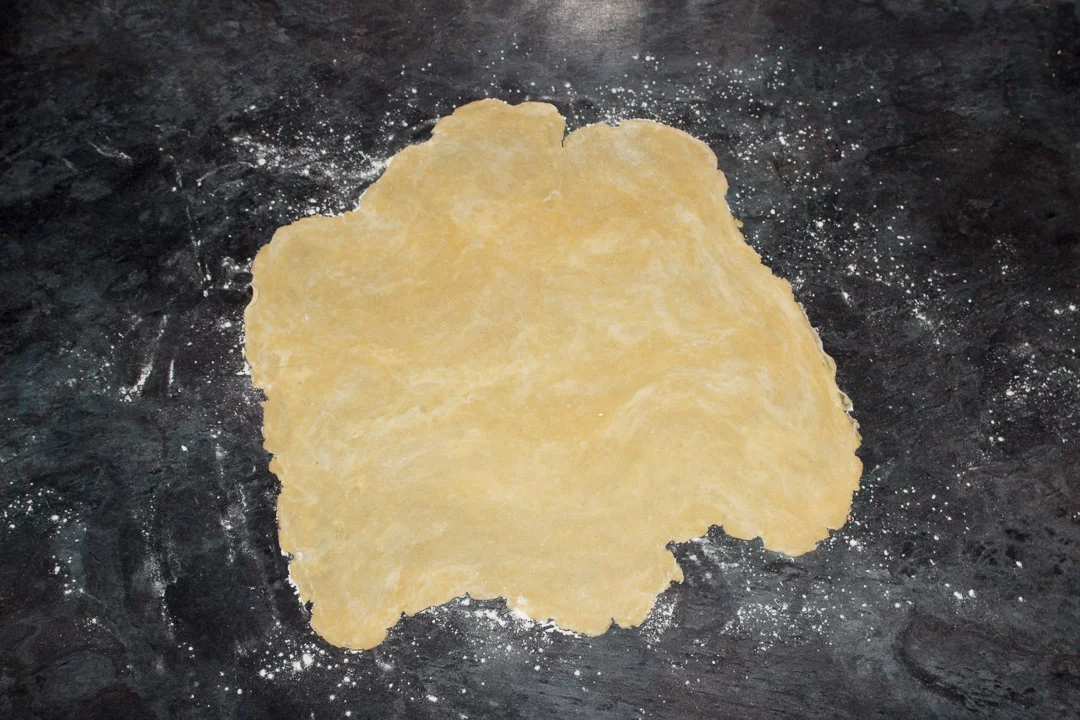
Then carefully lift your pastry over your tart tin and gently press it into the base and sides.
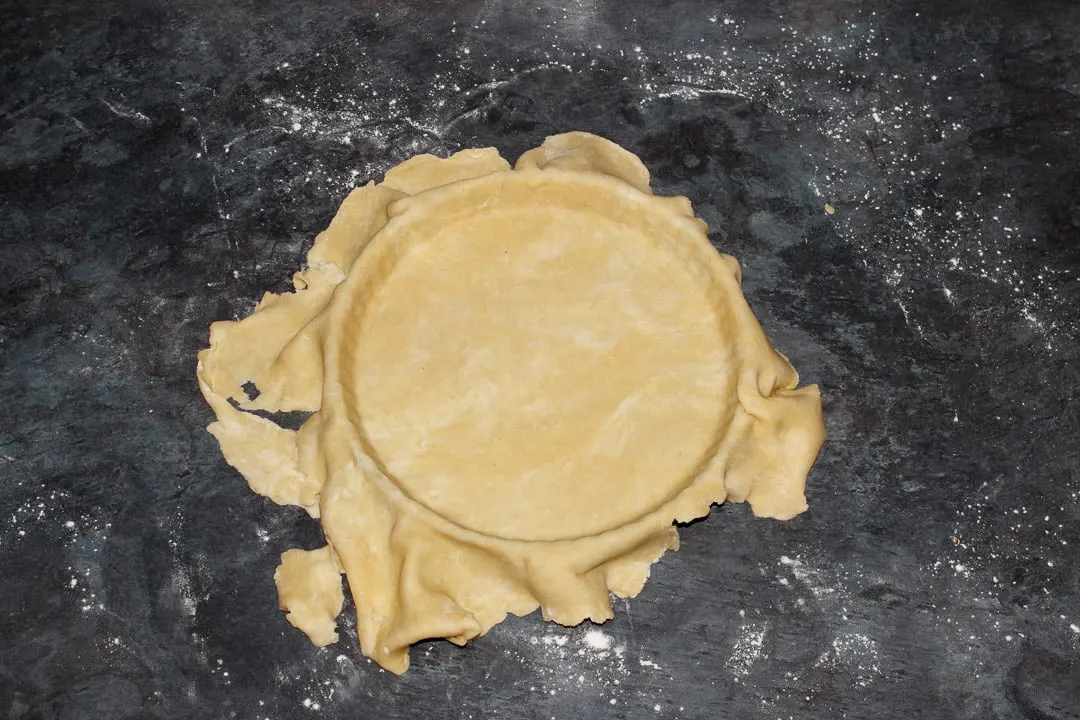
Next, roll your rolling pin over the top to cut off any excess pastry then gently prick the base all over with a fork.

Pop your prepared pastry in the freezer to chill and preheat your oven to 180°C/Fan 170°C/356°F.
Now scrunch up a large sheet of baking paper and place it into your pastry tin. Fill it with baking beans. (You can use coins or dried pulses etc if you don’t have those.)

Bake in the centre of your preheated oven for 15 minutes, then carefully remove the baking beans and baking paper. Lightly brush the whole thing with beaten egg.

Lastly, put your pastry case back into the oven for a final 10-12 mins until golden and crispy to the touch.

Allow to cool completely while you make the butterscotch filling.
Butterscotch filling instructions
First, whisk together the milk (100ml | 1/3 Cup + 1 tbsp) and flour (40g | 1/3 Cup) in a jug until smooth. Set to one side until needed.

Then add the cubed butter (175g | 3/4 Cup) and caster sugar (175g | 3/4 Cup + 1/8 Cup) to a large saucepan and set over a low/medium heat.

Stirring with a wooden spoon, heat until everything is melted and the sugar has dissolved.

Now gradually pour in the milk/flour mixture a little at a time. Stir well after each addition.


Once all the milk/flour has been added, bring the mixture to the boil. Continue to boil, stirring constantly, until thickened. You want a consistency that’s a bit like wallpaper paste. (It should take around 15 mins or so.)

Then remove from the heat and add the salt (pinch), vanilla (1 tsp) and butterscotch essence (1 tsp.)

Give it one last good stir to blend everything together.

Finally, pour the mixture into your pastry case and allow to set completely. I prefer to leave mine at room temperature but, especially if it’s a warm day, you might like to put yours in the fridge.
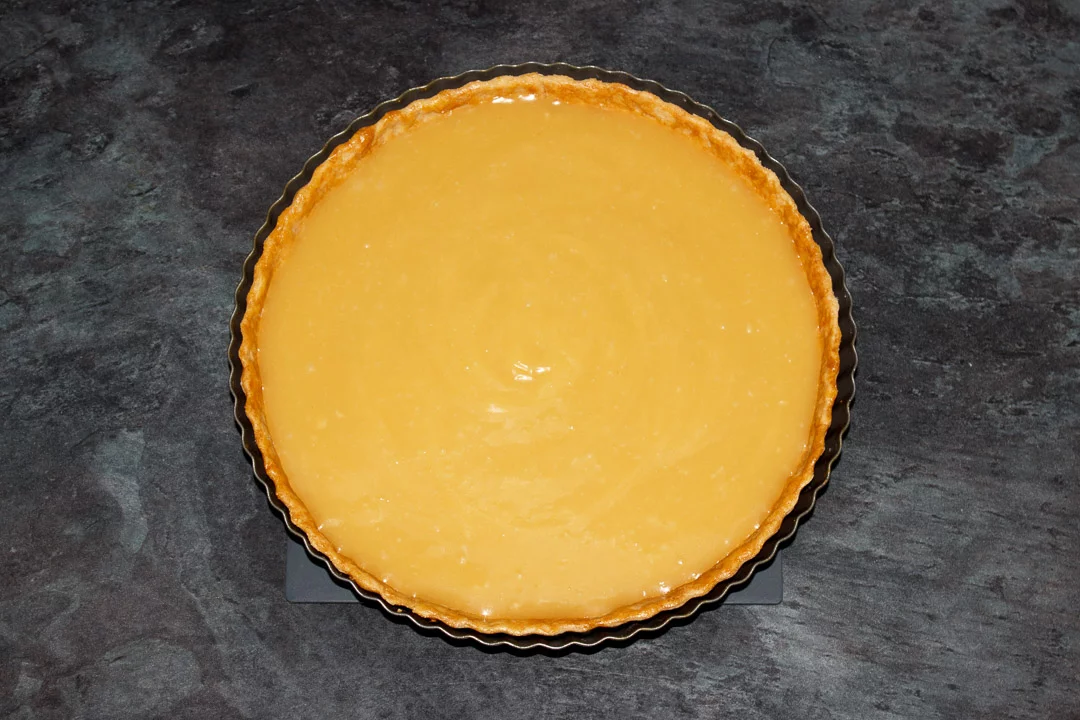
And there you have it my lovely! A seriously nostalgic and delightful butterscotch tart to call your very own. That beautiful, soft and gooey butterscotch filling on a gorgeously golden pastry crust… Just, yes. A thousand times yes!
Store your butterscotch tart in the fridge and consume within 5 days. (Although it’s at it’s best for the first 1 – 2 days.)

Other recipes you might like…
- Cornflake tart
- Treacle tart
- Victoria sandwich cake
- Lemon meringue pie
- No bake caramel chocolate tart

Have you Made This Recipe?
Will this classic dessert be making an appearance in your household? I’d love to know if it is! Send me your pics and comments on Facebook, Twitter and Instagram or email me at emma@kitchenmason.com.
Loved this Recipe? Pin it!

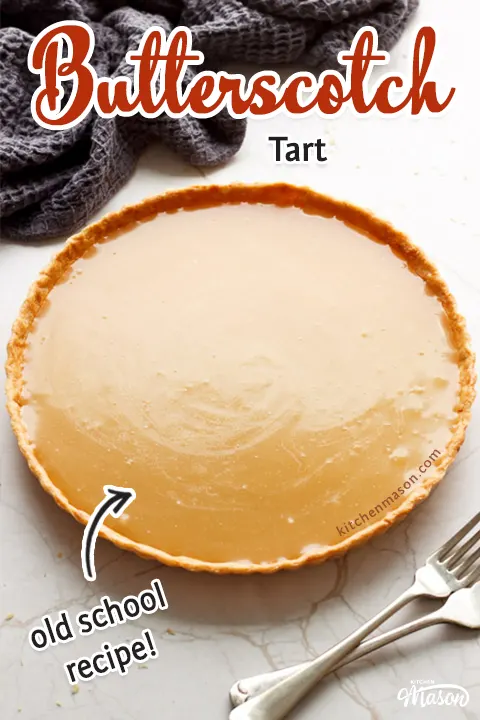

Old School Butterscotch Tart - Printable Recipe
Golden flaky pastry filled with a smooth and creamy butterscotch filling, this beautiful school dessert recipe will transport you straight back to your childhood!
Ingredients
For the Pastry
- 160g (1 + 1/3 Cups) Plain/All Purpose Flour
- 1/4 tsp Salt
- 85g (1/3 Cup + 1 tbsp) Unsalted Butter, cold & cubed
- 3 – 4 tbsp Cold Water
- 1 Egg, beaten (for brushing)
For the Filling
- 100ml (1/3 Cup + 1 tbsp) Whole/Full Fat Milk
- 40g (1/3 Cup) Plain/All Purpose Flour
- 175g (3/4 Cup) Unsalted Butter, cubed
- 175g (3/4 Cup + 1/8 Cup) Golden Caster Sugar
- Pinch of Salt
- 1 tsp Vanilla Extract
- 1 tsp Butterscotch Essence
Essential Equipment
- Pastry Blender (optional)
- Large Mixing Bowl
- Rolling Pin
- 20 cm/8″ Loose Bottomed Tart Tin
- Fork
- Baking Beans or Coins/Dried Pulses
- Jug
- Whisk
- Large Saucepan
- Wooden Spoon
Instructions
To Make the Pastry
- Either using a pastry blender or rubbing between your forefingers and thumbs, mix the flour, salt and butter in a large bowl until fine crumbs form.
- Gradually add the water and bring together to form a ball with your hands. It shouldn't be sticky.
- Wrap in cling film (saran wrap in the US), flatten into a disc and chill for 30 mins.
- Roll the pastry out to 2mm thick on a floured work surface then carefully lift over the tart tin. Gently press into the base and sides.
- Roll your rolling pin over the top to cut off excess pastry then prick the base all over with a fork. Place in the freezer and preheat your oven to 180°C/Fan 170°C/356°F.
- Line the pastry with scrunched up baking paper and fill with baking beans. Bake for 15 mins.
- Remove the baking paper and beans, brush all over with beaten egg and bake for a further 10-12 mins until golden.
To Make the Butterscotch Filling
- Whisk the milk and flour together in a jug until smooth. Set to one side.
- Melt the butter and caster sugar in a large saucepan set over a low/medium heat.
- A little at a time, add the milk/flour mixture, stirring well with a wooden spoon.
- Bring to the boil, stirring constantly, and cook until it thickens. (You are looking for a wallpaper paste like consistency.)
- Remove from the heat, stir through the salt, vanilla and butterscotch essence then pour into your pastry case. Allow to set at room temperature (or in the fridge on a warm day).
Notes
Store in the fridge and consume within 5 days. (Tastes best within 2 days.)
This recipe has been updated to improve the flavour and texture. If you would like a copy of the original recipe, please email me at emma@kitchenmason.com.
Recommended Products
As an Amazon Associate and member of other affiliate programs, I earn from qualifying purchases at no extra cost to you.
Nutrition Information:
Yield: 8 Serving Size: 1Amount Per Serving: Calories: 420Total Fat: 27gSaturated Fat: 17gTrans Fat: 0gUnsaturated Fat: 9gCholesterol: 71mgSodium: 102mgCarbohydrates: 42gFiber: 1gSugar: 23gProtein: 3g
Nutritional information on kitchenmason.com should only be used as a general guideline, I am not a certified nutritionist. Please always check labels for allergens where applicable.




Wendy Reeve
Saturday 3rd of July 2021
Hi Emma Just found your recipe and it sounds much better than the one that I use. I am going to make it for my family but my grandson is Celiac and can’t have wheat flour. I would make it on a gluten free biscuit base, but would like to know if you have ever made the butterscotch filling using cornflour or rice flour? It would be nice to give him something different. Thanks. Wendy
Emma
Saturday 3rd of July 2021
Hi Wendy. I’ve not personally tried it but I see no reason why using a different flour wouldn’t work. After all, it’s only for the purpose of thickening which, I’m fairly sure, most flours do? Just be sure to use GF pastry obviously. Emma x
Jan
Saturday 26th of June 2021
This sounds lovely but its not what we in Kent UK call gypsy tart. That uses only evaporated milk and brown sugar for the filling.
Emma
Sunday 27th of June 2021
Hi Jan. I didn't know this! I've never had gypsy tart myself, I just went on what other people have told me. (Some said it was also called gypsy tart.) Emma x
Larenka
Thursday 11th of March 2021
Most of the butterscotch receipes i have found don't even include flavouring (?!) So I jumped for joy when i saw this! I am currently waiting for it to set but the filling tasted quite flourey even though i stirred for a long time and not strong enough of butterscotch, so i added twice the amount of vanilla and b'scotch - Has anyone else found this too? Any tips? Nearly 99% there though! Thanks!
Emma
Friday 12th of March 2021
Hi Larenka. Sorry you've had a little trouble with this! With the flouriness - did you mix the flour into the milk before adding it to the melted butter/sugar? Also, did you add it gradually to the pan and not all in one go? Then cook until boiling and a thick, wallpaper paste like consistency? If you did those things you shouldn't really be able to taste the flour. I totally understand adding more flavouring - everyone has different tastes :) Emma x
Kitty
Sunday 5th of April 2020
I love butterscotch Tart so I was so excited when my brother started making it until I headed my dad and him arguing because he didn’t have the right ingredients he didn’t have the butterscotch essence or the caster sugar he used regular sugar instead .The butterscotch tasted like butter and sugar and the tart was over done the ingredients ARE really important but the next time he made it I gave him this recipe and it was delicious
Miss KitchenMason
Sunday 5th of April 2020
Aww that’s lovely Kitty! I’m so glad it worked well using my recipe :) Emma x
lita ashley
Wednesday 3rd of April 2019
So happy to have found this. It was my fave at school too. Also loved cawl at school in Wales, kind of soup/stew served with a slab of cheddar cheese, yum. Funny how it brings it all back and most of the dinners where great. Having said that, I blame the lunches on my generous hips, lol.
Miss KitchenMason
Wednesday 3rd of April 2019
Aww you're so very welcome Lita! I've not heard of cawl before (I grew up in the midlands - England) sounds yummy though :) Emma x